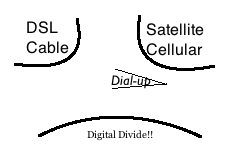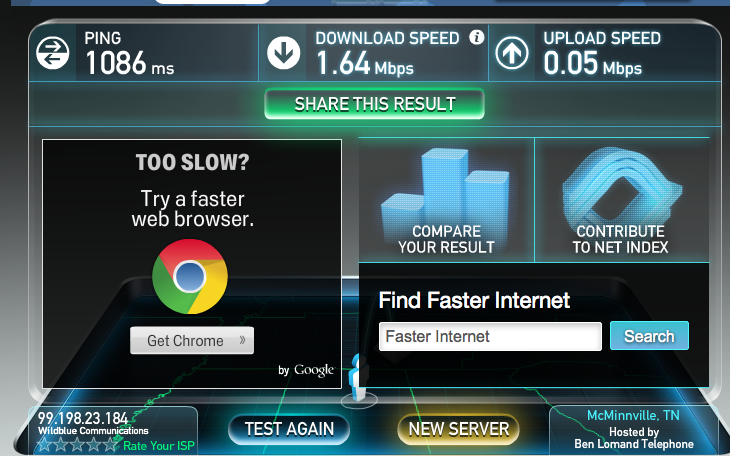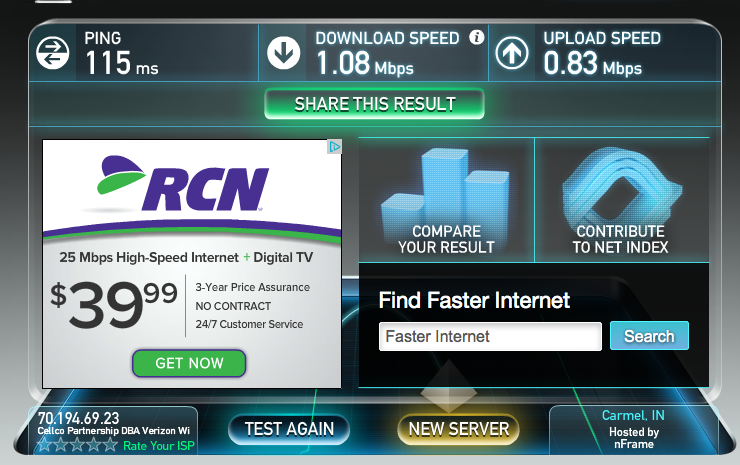Marty asked that I put something together on this, so I will reluctantly write about my Internet access options from home. For those that know me, you know that “home” at this point is in the proverbial sticks. Broadband Internet access is a need for me. It’s a utility and is just as important as running water or electricity. Kentucky has worked with providers to create a broadband map whereby one can search for Internet provider options based on street address.
A quick search of the map reveals that I almost have DSL service. Ironically, the amount of bandwidth you can obtain by being close to DSL service areas is zero. At least their mapping is accurate, as the broadband map indicates that I do have access to cable modem Internet service. I’ve talked to the cable provider in the area – Mediacom as best I recall – and they’ll tell you that I do NOT have cable service at my residence.
When you live away from these services, you’re really limited to satellite-based or cellular-based technology for Internet service. For two years, I’ve had Wildblue satellite Internet service. This morning, I did a quick SpeedTest with no other devices or streams connected. Results are:
Honestly, the 1.64Mbps down is not too bad. It’s slightly higher that the 1Mb/sec that I’m privileged to pay over $70/month for. The other figures are the ones that, depending on your needs, can be a killer. I’m supposed to be on a web-based conference call later today. That sort of two-way interaction does not work well with a ping time measured in SECONDS rather than milliseconds. I’ve tested it before and the delay is laughable. Note also that the upload speed is 0.05Mbps. That’s another detriment to any sort of communication where I am sending anything. Satellite can be an option for most basic Internet browsing and even the streaming of certain traffic. Once the connection is established and any latency is overcome, you’re potentially as fast as the beam from space can travel. In a scenario where I need to wait and respond (such as a conference call) or the source and destination change frequently (streams required from multiple sources, perhaps), there are regular requirements to break and establish different connections, which is not the strength of a satellite-based connection. Everything still has to travel from you to space and back to you, so there are certain things that can work and others that don’t work as well.
So, for at least part of the day, I’m testing out a Verizon MiFi device. Living in the sticks, 4G and LTE are some distance in the future. I can occasionally get 3G on my AT&T phone. This Verizon device works with a 3G signal, so what does SpeedTest show?
Well, I’m not quite as great on the download speed at the moment, but the ping times and upload speeds are more manageable. I’ve tested the web conferencing software and my hope is that it can at least function, albeit at a less-than-optimum rate. My traffic should just be going to the nearest cell tower and then to the provider’s network. I’m still relying on several pieces and parts, but I’m not waiting on traffic to leave and return to planet Earth, so traffic that is latency-sensitive should perform better with this device.
As long as I’m posting, I suppose I can mention (or mention again – I can’t recall) the prices and plans available.
Wildblue – Newest “Exede” service offers 12Mbps down, 3Mbps up – about $90/month including equipment rental gets you 15Gb of traffic in a 30-day period. That’s with a two-year contract and some one-time installation and account setup charges.
Verizon – This JetPack I’m testing is what’s linked. Appears to be $50 for the device (with a two-year contract). I can connect up to 5 devices at once to it. I may need to scratch that, though, as I feigned a purchase online and found this:
So it’s $20/month for the device and the data plans start at 4GB of shared data for $30/month and go up in 2GB/$10 increments, so 12GB of shared data prices out at $20/month for the device + $70/month for the data. That’s $90/month plus miscellaneous taxes and fees.
AT&T – If I could get DSL, I could get up to 6Mbps downstream for $20/month for the first year. After the first year, I might have to pay the regular price of $43/month. That’s just over ½ of what I’m paying for 4-6 times the download speeds. Oh, and that gets me 150Gb of data per billing period. After that, it’s 50Gb for $10. Not 2Gb for $10 as you read above… 50. In fact, the linked AT&T FAQ page states that the average AT&T High-Speed Internet customer uses only about 21Gb/month. So it appears that either the satellite or cellular plans allow for me to spend over twice as much per month and obtain enough bandwidth to go just over half of what the average AT&T DSL customer uses.
Why did I even start writing this? It just infuriates me more as I type and research. I was going to look up the cable modem options, but why bother? It allows me to bundle phone, Internet and cable television. Their LOWEST plan is 3Mbps downstream with 150Gb of data.
So there it is. It’s my version of the digital divide and I think it’s becoming closer to the common version. With cellular and satellite technology available, the number of households that CANNOT get “high speed” Internet access is very small. I post this to point out that the cost and features of the satellite/cellular options are nothing like the cost and features of the DSL/cable options.
Here’s some food for thought. If you believe the writers of that article, some youth of today value mobility and connectivity more than houses and cars. I’m not quite there yet, but I will definitely say that, in my line of work, true broadband availability will be a major consideration (as might be things like the schools and neighborhood) should I ever choose to relocate.
If my testing reveals anything of use, I’ll return later. For now, I’m off to cry about living in an area with limited Internet connectivity options. Wait… I guess I just did that.



